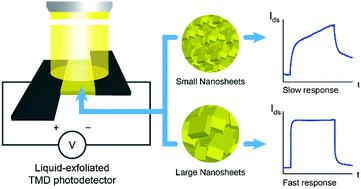当前位置:
X-MOL 学术
›
Mater. Horiz.
›
论文详情
Our official English website, www.x-mol.net, welcomes your
feedback! (Note: you will need to create a separate account there.)
Engineering the photoresponse of liquid-exfoliated 2D materials by size selection and controlled mixing for an ultrasensitive and ultraresponsive photodetector
Materials Horizons ( IF 12.2 ) Pub Date : 2020-10-26 , DOI: 10.1039/d0mh01493a Fuad Indra Alzakia 1, 2, 3 , Baoshan Tang 2, 3, 4 , Stephen John Pennycook 1, 2, 3 , Swee Ching Tan 1, 2, 3
Materials Horizons ( IF 12.2 ) Pub Date : 2020-10-26 , DOI: 10.1039/d0mh01493a Fuad Indra Alzakia 1, 2, 3 , Baoshan Tang 2, 3, 4 , Stephen John Pennycook 1, 2, 3 , Swee Ching Tan 1, 2, 3
Affiliation

|
The performances of percolating thin-film photodetectors fabricated from liquid-exfoliated 2D materials such as MoS2 and WS2 are inferior compared to their single-crystalline counterparts due to the low-mobility arising from edge defects and inter-nanosheet resistance. Moreover, the mechanism controlling the photoresponse time is not well understood. In this study, we demonstrated better control of the photoresponse time via the size selection of the liquid-exfoliated nanosheets via cascade centrifugation. We discovered that a faster photoresponse was observed when using a large average nanosheet size, while a much slower response was observed when using small nanosheets, giving rise to the linear component of the photoresponse in addition to the exponential component. Furthermore, we discovered that mixing a controlled proportion of WS2 and graphene nanosheets exactly at the percolation threshold results in a significantly increased photocurrent, up to 40 times higher compared to the pure WS2 photodetector, due to good interfacial charge transfer between WS2 and graphene, reaching a responsivity of 1.15 A W−1 under blue light. Above the percolation threshold, the photocurrent vanishes due to increased dark current noise. This strategy of nanosheet size-selection and controlled mixing with graphene opens up the possibility for 2D material photodetectors fabricated via liquid-exfoliation to be more competitive with their single-crystalline counterparts. We believe that this approach can be applied to other emerging 2D materials, such as phosphorene, MXene, and graphitic carbon nitride.
中文翻译:

通过尺寸选择和受控混合来设计液体剥离二维材料的光响应,以用于超灵敏和超响应的光电探测器
由液体剥落的2D材料(例如MoS 2和WS 2)制成的渗透薄膜光电探测器的性能比其单晶同类产品差,这是由于边缘缺陷和纳米片间电阻引起的迁移率低。而且,控制光响应时间的机制还不是很清楚。在这项研究中,我们证明了通过液体剥落纳米片的尺寸选择,可以更好地控制光响应时间。级联离心。我们发现,使用较大的平均纳米片尺寸时,观察到较快的光响应,而使用较小的纳米片时,则观察到较慢的光响应,除指数成分外,还产生了光响应的线性成分。此外,我们发现恰好在渗滤阈值下混合可控比例的WS 2和石墨烯纳米片会导致光电流显着增加,这是纯WS 2光电探测器的40倍,这是由于WS 2和WS之间的良好界面电荷转移所致。石墨烯,响应度达到1.15 AW -1在蓝光下。超过渗透阈值,由于暗电流噪声增加,光电流消失。纳米片尺寸选择和与石墨烯的受控混合的这种策略为通过液体剥落制造的2D材料光电检测器与单晶对应物更具竞争力提供了可能性。我们相信,这种方法可以应用于其他新兴的2D材料,例如磷烯,MXene和石墨氮化碳。
更新日期:2020-11-06
中文翻译:

通过尺寸选择和受控混合来设计液体剥离二维材料的光响应,以用于超灵敏和超响应的光电探测器
由液体剥落的2D材料(例如MoS 2和WS 2)制成的渗透薄膜光电探测器的性能比其单晶同类产品差,这是由于边缘缺陷和纳米片间电阻引起的迁移率低。而且,控制光响应时间的机制还不是很清楚。在这项研究中,我们证明了通过液体剥落纳米片的尺寸选择,可以更好地控制光响应时间。级联离心。我们发现,使用较大的平均纳米片尺寸时,观察到较快的光响应,而使用较小的纳米片时,则观察到较慢的光响应,除指数成分外,还产生了光响应的线性成分。此外,我们发现恰好在渗滤阈值下混合可控比例的WS 2和石墨烯纳米片会导致光电流显着增加,这是纯WS 2光电探测器的40倍,这是由于WS 2和WS之间的良好界面电荷转移所致。石墨烯,响应度达到1.15 AW -1在蓝光下。超过渗透阈值,由于暗电流噪声增加,光电流消失。纳米片尺寸选择和与石墨烯的受控混合的这种策略为通过液体剥落制造的2D材料光电检测器与单晶对应物更具竞争力提供了可能性。我们相信,这种方法可以应用于其他新兴的2D材料,例如磷烯,MXene和石墨氮化碳。











































 京公网安备 11010802027423号
京公网安备 11010802027423号